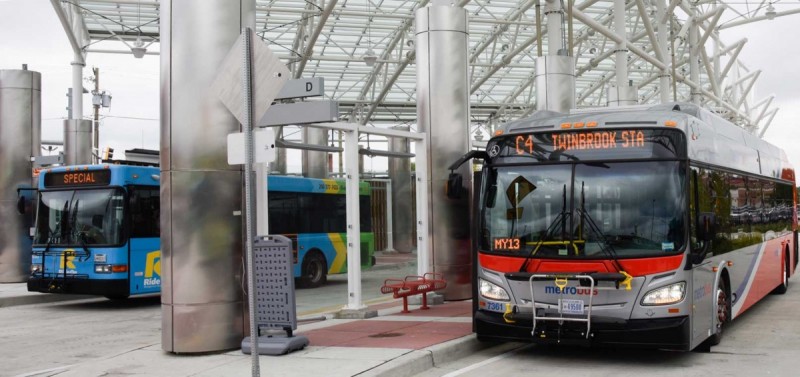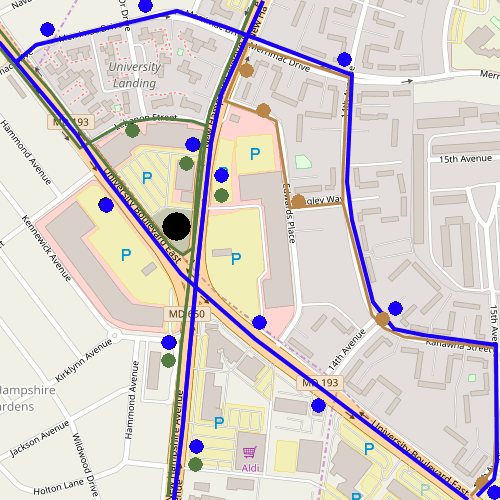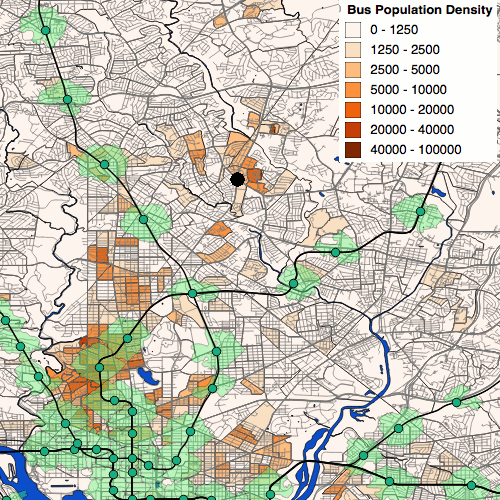Langley Park’s new transit center opened on Thursday!

Buses at the new Takoma Langley transit center. Image by WMATA.
A major new bus station opened in Prince George's County on Thursday. Located on the Montgomery County Border at the intersection of New
Hampshire Avenue and University Boulevard, the long-awaited Takoma-Langley Crossroads Transit Center will make taking the bus through the area— and, in particular, transferring between buses— far easier and safer.
The transit center will have 12 total bus bays. Six WMATA bus lines, four Montgomery County RideOn lines, and both a Prince George's County The Bus line and a University of Maryland student shuttle will either run through or terminate there, meaning it will be easier to transfer between buses.
Previously, four RideOn routes terminated in a clockwise loop on side-streets northwest of the transit center, one The Bus route terminated in a clockwise loop on side-streets northeast of the transit center, and and a WMATA route terminated in a counter-clockwise loop on a different set of side-streets north of the transit center. Meanwhile, other WMATA, RideOn, and University of Maryland student shuttle routes ran directly along University Boulevard and New Hampshire Avenue.
Bus service patterns before the transit center opened, with the large black dot being the transit center. Blue lines and stops are WMATA routes, brown ones are The Bus, and dark green are RideOn. Image by Author with a base map from OpenStreetMaps.
Consolidating the bus stops on the routes passing through the intersection into one location will also make things a lot safer. The intersection of New Hampshire Avenue and University Boulevard is one of the most dangerous for pedestrians in the DC area. One major cause of pedestrian fatalities has been the fact that, although it is the largest bus transfer point in the DC area not located at a Metro station, transferring between buses has required crossing one or two six-lane roads.
Getting ready for today's ribbon-cutting at the new Takoma Langley Crossroads Transit Center, funded by #TIGER! @mtamaryland @MWCOG pic.twitter.com/GI5KEQH9A6
— TPB (@NatCapRegTPB) December 20, 2016
The transit center will also provide restroom facilities as well as a safer and more comfortable waiting environment for passengers than the area's narrow sidewalks.
The Maryland Transit Authority will operate the transit center, making it the first transit facility in the DC region where that's the case. The MTA provides local transit in the Baltimore area, and runs MARC and a state-wide system of commuter buses as well.
The ribbon has been cut! Takoma Langley Crossroads Transit Center will open this Thursday. pic.twitter.com/CGikOZxu5w
— TPB (@NatCapRegTPB) December 20, 2016
While construction work on the Purple Line is still delayed by court order, the new transit center is a major piece of infrastructure along its route. Locate roughly at the future light rail line's midpoint, the transit center will be particularly useful in linking the K-series Metro buses on New Hampshire Avenue to rail; currently, they're the only Metro buses in Maryland that do not stop at any rail station outside of the District.
The transit center is not only a transfer point, though. With large shopping centers on each of the four corners of the intersection of University Boulevard and and New Hampshire Avenue, it is a significant destination. Furthermore, Langley Park is home to one of the region's densest populations of people who commute to work primarily by bus.
The Takoma-Langley Transit Center (black dot) is located in an area with one of the highest densities of people who commute to work by bus in the DC suburbs. Image by the author.
Plans for the center have been in the works for over a decade. In July 2006, Robert L. Flanagan, then Maryland's Secretary of Transportation, wrote to the Washington Post that the transit center— along with the Silver Spring Transit Center, which opened in September 2015, five years behind schedule— was “fully funded and scheduled to start construction within months.” However, a dispute with the owner of the land on which the center was to be built was not resolved until 2013.
Construction on the transit center was completed in August and, as planned, WMATA took possession of the property for transit operations under a lease agreement from the MTA. However, delays due to WMATA's more stringent requirements for opening the center and higher estimated cost for operating it led to the MTA's decision to operate the facility itself.
